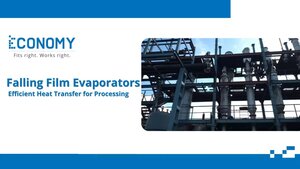Falling Film Evaporators: Efficient Heat Transfer for Processing
الجسم
Falling film evaporators are highly efficient heat transfer systems widely used in the processing industry for concentration, solvent recovery, and temperature-sensitive separations. They are particularly favored in applications requiring gentle thermal treatment to prevent the degradation of heat-sensitive materials. Their design and operational efficiency make them an integral component in sectors such as food and beverage, pharmaceuticals, chemicals, and environmental management.
Principle of Operation
A falling film evaporator consists of a vertical shell-and-tube heat exchanger, with the feed entering at the top of the unit. As the liquid feed is distributed over the tube's inner surface, it forms a thin film that flows downward under gravity. Heating medium (usually steam or hot water) circulates in the shell side, providing the energy needed for the liquid within the tubes to evaporate.
The key to its efficient heat transfer lies in the film's thinness, which ensures rapid heat transfer and uniform temperature distribution, minimizing thermal degradation. The vapor generated during this process is typically removed and condensed, while the concentrated liquid product is collected at the bottom.
Advantages
There are several advantages of falling film evaporators that make them a preferred choice in many industrial applications, especially where efficient heat transfer and the quality of heat-sensitive products are of paramount importance. High Thermal Efficiency: The thin film ensures efficient heat transfer, allowing for lower temperature differences between the heating medium and the liquid being evaporated.
Reduced Thermal Degradation: The product's brief exposure to heat and the uniform distribution of temperature help in preserving the quality of heat-sensitive materials.
Low Energy Consumption: The efficiency of heat transfer and the ability to operate under vacuum (for lower boiling temperatures) contribute to lower energy consumption.
Scalability and Flexibility: These evaporators can handle a wide range of feed rates and concentrations, making them adaptable to various processing requirements.
Ease of Cleaning and Maintenance: The vertical configuration and smooth flow dynamics reduce fouling and sedimentation, facilitating easier cleaning and maintenance.
Applications
Food Industry: Concentration of fruit juices, milk, and other dairy products.
Pharmaceutical Industry: Gentle evaporation of solvents from heat-sensitive drug compounds.
Chemical Industry: Recovery and purification of chemicals, solvents, and acids.
Environmental Management: Treatment of wastewater and recovery of valuable components.
Design Considerations
When designing a falling film evaporator, several factors must be considered to optimize performance:
Feed Characteristics: The nature of the feed (viscosity, fouling tendency, thermal sensitivity) dictates the design and operational parameters.
Heat Transfer Requirements: Calculating the necessary heat transfer area and understanding the heating medium's properties are crucial.
Material of Construction: The evaporator's materials must be compatible with the feed and cleaning chemicals to ensure durability and prevent contamination.
Operational Flexibility: The system should be capable of handling variations in feed rate and composition without sacrificing efficiency.
In conclusion, falling film evaporators represent a cornerstone technology in efficient heat transfer for the processing industry, offering remarkable advantages in terms of energy efficiency, product quality, and operational flexibility. Their ability to cater to a diverse array of industrial applications underscores their importance in modern manufacturing and environmental management processes.






تعليقات